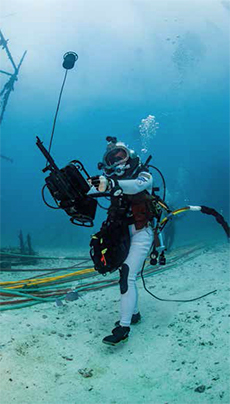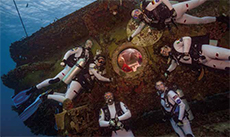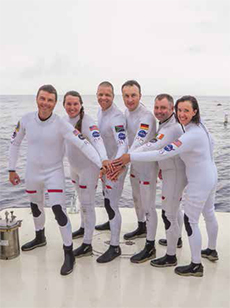




| Home | Features | Club Nights | Underwater Pics | Feedback | Non-Celebrity Diver | Events | 8 August 2025 |
| Blog | Archive | Medical FAQs | Competitions | Travel Offers | The Crew | Contact Us | MDC | LDC |

|

|
 
 |
   ISSUE 23 ARCHIVE - NEEMO XXIDawn KernagisIn order to prepare hardware, software, protocols, and human beings for space, space agencies are first testing many of these things in another extreme environment by sending them undersea.Living on the bottom of the Atlantic Ocean, the NASA Extreme Environment Mission Operations (NEEMO) evaluates tools and techniques being tested for future space exploration by living in simulated spacecraft conditions and conducting simulated spacewalks outside of their undersea habitat. This past summer, the 21st NEEMO crew and two professional habitat technicians lived in saturation at 62 feet (19 meters) below the surface of the Atlantic Ocean at The Aquarius Undersea Reef Base, owned and operated by Florida International University under permit by NOAA and the Florida Keys National Marine Sanctuary. Inside the habitat, the international crew conducted a variety of research and operational studies, such as testing a mini DNA sequencer and a medical telemetry device that will be used for future space applications. During their simulated spacewalks, the crew collected samples for marine biology and geology studies, teamed with underwater remote operating vehicles, tested operational software, and participated in a coral restoration project. Throughout many of these tasks, the mission also tested time delays in communications to simulate scenarios often encountered in space exploration. NASA astronaut Reid Wiseman was the commander for the first 8 days of the NEEMO 21 mission aboard the Aquarius laboratory. Wiseman flew in space as part of Expedition 40/41 in 2014, spending 166 days living and working in the extreme environment of microgravity aboard the International Space Station. Wiseman was a naval aviator and test pilot prior to joining NASA in 2009. NASA astronaut Megan McArthur Behnken commanded the second half of NEEMO 21 and will live in the habitat for the entire 16-day mission. Behnken has served as a Capsule Communicator for both the space shuttle and space station, and she flew on the STS-125 shuttle mission in 2009. Prior to joining NASA, Behnken obtained her PhD in Oceanography at Scripps Institution of Oceanography. Joining Behnken for the entire 16 days was Matthias Maurer (European Space Agency astronaut). For the first 8 days, Dr. Marc O'Griofa (Veterans Administration researcher) joined Wiseman, Behnken, and Maurer. For the second half of the mission, Behnken and Maurer were joined by Dr. Dawn Kernagis (researcher at the Institute for Human and Machine Cognition) and Dr. Noel Du Toit (Naval Postgraduate School researcher). As a former technical diver-turned-research scientist and in addition to her duties as a crew member, Dawn Kernagis conducted experiments that expanded on previous work she conducted as a graduate student on the molecular effects of diving. Specifically, she investigated changes to how our genes are expressed (known as 'epigenetic' changes), which could potentially be adaptive responses to living in a saturation diving environment like NEEMO, as well as changes to the bacteria that live in our gut. Epigenetic changes are potentially permanent and inheritable by future offspring and could affect how we adapt to saturation diving or breathing elevated levels of oxygen for an extended period of time. Potentially driving some of these molecular changes are signals from the bacteria that live in our gut. It has been estimated that for each human cell in our body, we have 10 bacterial cells that also inhabit our body and many of these bacteria live in our gut. These bacteria have been shown to drive adapative responses to changes in nutrition, fitness, and in response to various stressors, so Kernagis was looking at how living in saturation affects the make-up of our gut bacteria. Ultimately, understanding these molecular level changes in response to saturation diving and living in extreme environments is important for optimizing health and performance for humans going undersea or into space. |